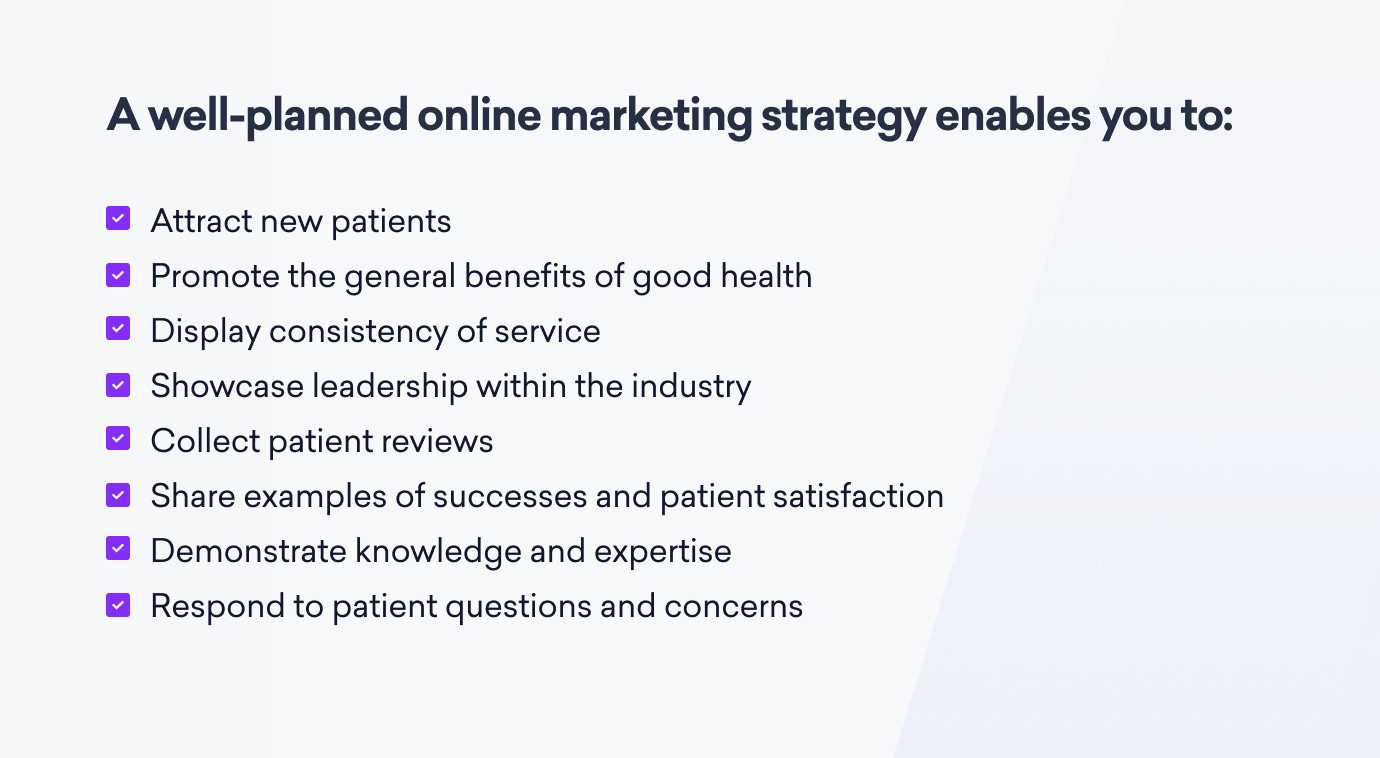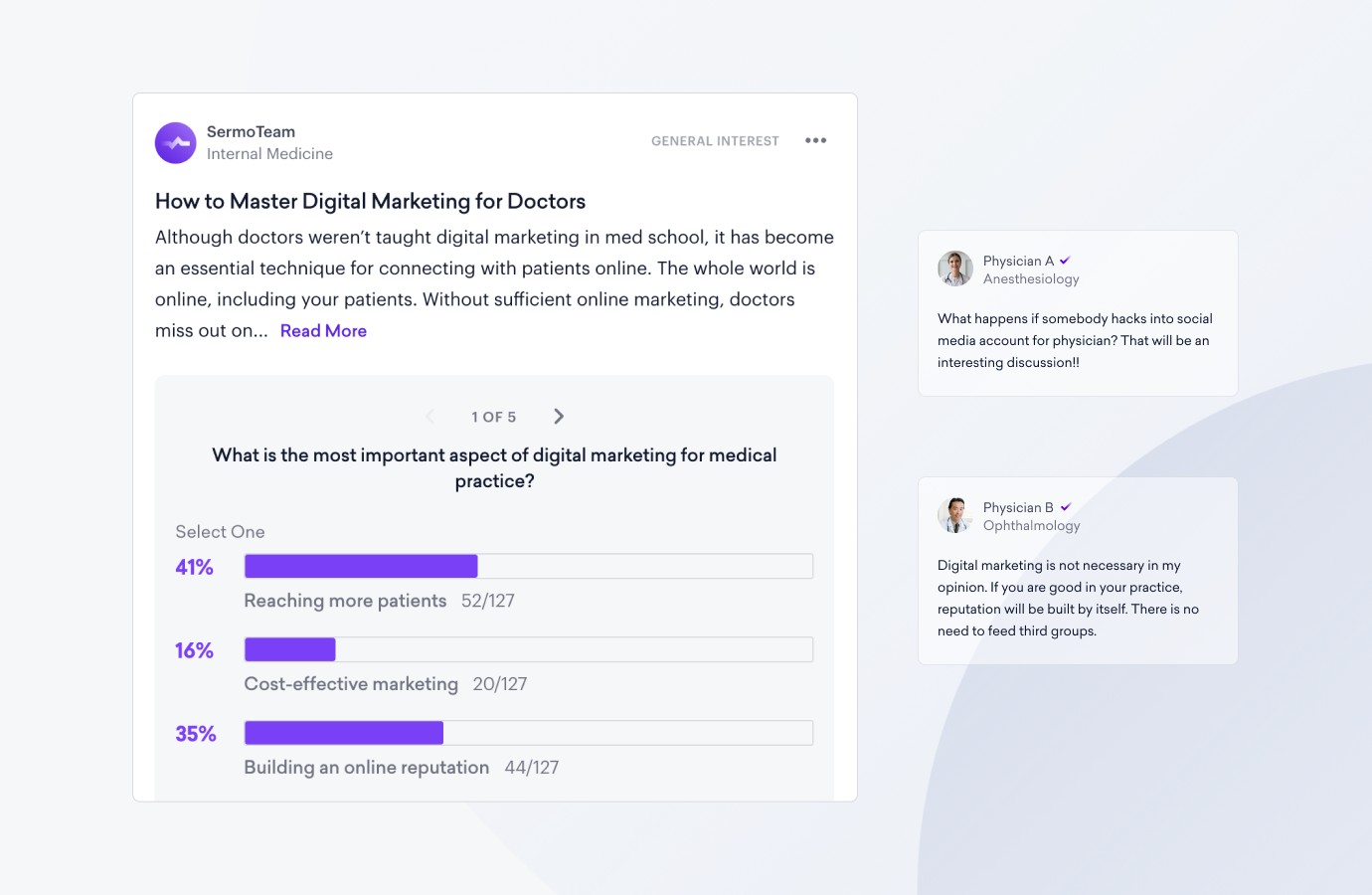
Most doctors never learn digital marketing in medical school. However, without the right online marketing strategies, physicians miss out on attracting new patients and are left behind by local competitors. With 90% of patients using online reviews to choose their doctor, do you really want to leave your online reputation and long-term success to chance?
Healthcare digital marketing can feel overwhelming at first, especially when you have so many other responsibilities as a doctor. Fortunately, Sermo has you covered, so you no longer have to hang your entire business on word of mouth or referrals. Dive into our comprehensive guide as we explore the best healthcare marketing strategies to help your medical clinic establish a predictable system for attracting the right kind of new patients and rank as the top local choice.
The importance of digital marketing for medical practices
Physician digital marketing offers an opportunity to promote your services and practice online, often at a minimal cost. The goal of online marketing for doctors is to attract new patients by showcasing your expertise, building trust, and alleviating the stress associated with doctor visits, while simultaneously bolstering your reputation and industry standing.

In a Sermo survey of medical professionals, 38% considered digital marketing to be important for reaching more patients, and 36% said it was integral to building their online reputation.
Identifying your target audience as a doctor
With a sea of healthcare choices, the best way to stand out as the go-to choice is to focus your marketing on a target niche of patients. This allows physicians to create content focused on the unique needs and pain points of your ideal patients, which increases the likelihood of attracting qualified patients who understand your unique specialty and expertise and stay loyal for the long term.
To build a healthcare marketing strategy based around a single ideal patient profile, answer these identifying characteristics:
- Patient geography — Target territory defined by ZIP codes, considering realistic distance and barriers. Most patients travel less than 10 miles for non-emergency care, so plan accordingly.
- Patient demographics — Target audience’s age, gender, family composition, occupation, education, and household income.
- Patient psychographics — Target audience’s personality, hobbies, lifestyle, internal and external motivators, average clinic loyalty, and receptiveness to new ideas/technology.
- Patient behavior — Target audience’s needs, wants, knowledge, information sources, consumer patterns, and healthcare visitation rate.
How to build a strong brand identity as a physician
After identifying a clear target audience, the next step in your healthcare marketing strategy is to develop a cohesive brand identity. First, decide who will own the marketing campaigns for your practice.
According to a recent Sermo poll, doctors answered “who is responsible for content marketing in your medical practice?”:
- 23% – I handle it myself or with other doctors
- 29% – My workplace has a dedicated marketing department
- 9% – My office staff manages it in their spare time
- 6% – I hire a freelance marketer for content creation
- 32% – No one is currently doing content marketing for my practice
Physician branding combines clinical expertise, reputation, and personality to build recognition among peers, patients, and the healthcare community. A Sermo survey found that 60% of doctors reported that branding has a positive impact on their careers, opening up networking opportunities and positioning them as thought leaders in their specialty.
Defining your unique value proposition (UVP)
A unique value proposition (UVP) for a medical practice should clearly communicate what sets the clinic apart from competitors by focusing on distinct benefits it offers to patients, such as personalized care, convenience, or specialized expertise.
It must be concise, patient-centered, and highlight how the practice uniquely addresses patient needs or solves their problems better than others. Crafting a UVP involves understanding the target patient demographic, identifying market gaps, and using clear, compelling language that resonates emotionally with patients to attract and retain them effectively.
Creating a professional and patient-friendly brand for a medical practice
Consistency and empathy in branding help the practice stand out and resonate emotionally with patients. Start by developing a clear and consistent brand identity that reflects the clinic’s values, personality, and unique offerings across all touchpoints, including logo, colors, and communication style. Additionally, prioritize designing a welcoming patient experience with approachable messaging and cohesive visuals to build trust and foster long-term patient relationships.
Ensuring consistency across online and offline platforms
Develop a comprehensive brand guidelines document that details your visual identity, messaging, and tone, and make it accessible to all staff and marketing teams. Additionally, standardize internal communication and training while regularly auditing brand implementation and gathering feedback to maintain a consistent and authentic brand experience at every patient touchpoint.
Build your personal brand as a physician
While marketing a practice and building a personal brand require similar strategies, personal branding is delivered from your viewpoint instead of the practice’s viewpoint. Establish a consistent online presence by using professional photos and a clear, candid, and concise message across all platforms. Share valuable and engaging content related to your medical expertise to position yourself as a thought leader. Interact authentically with your audience and other professionals to build a strong, trusted network.
For example, a plastic surgeon might build a personal brand on being a specialist in a particular type of procedure, or a GP might become known for effectively dealing with a specific demographic of patients in order to stand out.
For more tips on building your personal brand as a physician, see our guide here.
8 medical practice marketing and advertising strategies
For most practitioners, marketing ideas for doctors’ offices present a complex challenge. As a physician on Sermo shares, “Marketing does not come easily to physicians. We don’t have the training or skills to market and promote our practices. Most physicians have little background and understanding of the importance of marketing techniques in building their medical practices. Applying basic marketing principles can enhance existing patients’ experience and attract new patients to your practice.”
After all, you’re a physician, not a website guru or social media expert. There are dozens of social media platforms, review sites, referral programs, business listing directories, as well as paid advertising, SEO, email newsletters, website marketing, and content marketing to choose from. If you’re going to spend time, money, and resources on digital marketing for doctors, you want to know it will pay off. So, what marketing strategy should you adopt first?
Here’s what experts recommend as a comprehensive healthcare marketing strategy, regardless of your clinic size or location.

1. Define your target audience
As discussed above, many doctors fall into the trap of casting their net as wide as possible, hoping to attract a wide variety of patients. In reality, this strategy never works because it makes it impossible for patients to differentiate you from competitors. Defining your audience helps you create the right content and select the most effective communication channels where your ideal patients are likely to be found online.
For example, pediatricians should look at building relationships with obstetricians to strengthen referral networks and focus on digital marketing channels that appeal to parents and family groups. On the other hand, geriatricians would be better off concentrating their relationship-building efforts on family doctors and nursing facilities, while leveraging social media channels that appeal to the questions and pain points of older populations.
2. Get active on social media
56% of surveyed doctors agreed that the biggest benefit of using social media was increased visibility, while 18% of respondents reported using social media to market themselves and their medical practices. Social media marketing for doctors can directly influence patient decisions when selecting a specific provider or seeking a second opinion. You can also open channels of communication with your patients via social media. A recent Sermo survey found that 12% of respondents reported gaining patient insights from their digital marketing efforts.
Which channels you post on will depend on your target audience. For example, 71% of Instagram users are under 35, whereas 72% of 50- 64-year-olds use Facebook. Having active profiles on relevant channels drives patient engagement. It attracts new patient appointments to grow your medical practice, while establishing your expertise in the healthcare community and opening up a wide array of opportunities.
Still need convincing? Check out these social media marketing stats:
- 70% of the US population has active social media accounts.
- 80% of internet users look for health information on social media.
- 60% of patients say they trust doctors’ posts on social media.
- 41% of patients use social media to decide on their health care providers.
- 40% of patients say facts found through social media affect how they deal with treatments.
3. Focus on local business
When developing strategies for online marketing, doctors should concentrate on their local area. Patients typically choose doctors within a 15-mile radius of their home rather than traveling long distances. This is confirmed by Google consumer insights, which report a 900%+ increase in “near me tonight/today” searches over a two-year period.
One of the best medical clinic marketing strategies to capitalize on local search is to set up a Google Business Profile. This tool is free and helps patients find your practice more easily. Personalize your Google Business Profile with photos, offers, hours, contact info, and more. Additionally, you can boost your local SEO and develop web pages and articles with location-based keywords. For example, “best cardiologist in San Francisco,” “pediatric services in Austin,” or “cosmetic surgery in Tampa.” These are known as long-tail keywords and will significantly increase your local reach. or “cosmetic surgery in Tampa.” These are known as long-tail keywords and will significantly increase your local reach.

4. Join professional networks
Physician social networking communities, such as Sermo, provide a secure space for healthcare professionals to connect with peers and facilitate global collaboration on important industry matters. In fact, 19% of Sermo members reported using social media for community engagement and sharing important medical information. Professional networking is about so much more than collecting names and acquaintances within your industry; it’s about sharing real-life insights and patient cases with your peers.
5. Optimize your website
Your website’s appearance and ease of navigation are essential components of your online presence. To maximize patient conversions, ensure it loads quickly, aligns with your brand identity, is written to attract your ideal patient, and is easy to schedule appointments. In a Sermo survey, 26% of doctors identify their business website as the most influential part of their online presence. However, with just a couple of tweaks to account for technical considerations, it’s possible to get ever more reach and benefits:
- Is your website mobile-friendly? Over 80% of internet traffic is now done through mobile devices. If your website isn’t mobile-friendly, visitors will leave immediately, and it won’t appear in search engine results, and your organic traffic will plummet. Research shows that 61% of consumers are more likely to contact local businesses with mobile-friendly sites.
- Is your website SEO optimized? Updating your web copy with relevant keywords, ensuring accurate metadata and alt tags, including sufficient internal and external links, and setting a focus key phrase for each page will improve your Google ranking. Additionally, hosting blog articles on your website that focus on the keywords your target audience is searching for can dramatically increase your SEO ranking on search engines and send you consistent traffic. 39% of doctors in a recent Sermo survey said Google is the most influential part of their online presence, which proves how successful you can be if you spend time building a solid SEO strategy.
6. Generate patient reviews
Controlling the narrative is a key part of online reputation management for doctors. Research shows that 9 out of 10 patients use online reviews to evaluate doctors, and 75% will only consider doctors with a rating of 4 stars or higher.
Establish a staff-wide process to professionally ask for patient reviews. We recommend setting up a QR code at the front desk and asking for a review after treatment. Be sure to explain how online reviews help others in the community discover the clinic and its services. The best places to ask for reviews are:
- Google my business profile
- Social media channels
- Yelp
- ZocDocs
- WebMD
- RateMDs
- Healthgrades
7. Leverage content marketing
Understanding complex medical terminology, processes, and procedures can be intimidating for patients. Explaining your services and showcasing your expertise through email marketing campaigns, blog articles, and webinars are fantastic ways to build patient trust and confidence.
In a recent Sermo poll, physicians shared what content they primarily use to market their medical practice:
- 12% Blog posts/articles
- 22% Social media posts (e.g., Facebook, Instagram, Twitter)
- 10% Educational videos (e.g., YouTube, TikTok)
- 12% Email newsletters
- 16% Patient testimonials and success stories
- 8% Webinars or live Q&A sessions
- 11% Infographics and visual content
- 9% Other
Use your content to answer common questions, address target audience pain points, and share patient success stories (with their consent). By adding relevant SEO keywords across content, you’ll simultaneously improve your Google ranking and further increase your online visibility. Although it requires a little extra planning, try to incorporate videos where possible, as they generate up to 66% more qualified leads.
8. Invest in paid advertising
Medical practice advertising is the quickest way to generate attention and new leads for your business. With social media competition increasing each year, it’s vital to dedicate a budget for paid advertising to help bolster your organic social media and website strategies.
The highest quality medical practice advertising platforms are generally considered to be Google, Facebook, and Instagram. Focus your advertising on the platforms where your target audience spends their time online. With Google ads, you pay to rank at the top of Google search results for your target keywords.
For Meta ads, you must create content with a strong hook, a compelling story, and a clear call to action that addresses your target audience’s specific challenges and needs. By leveraging your ideal patient profile, you should run ads that target key characteristics based on age, interests, behaviors, geography, and demographics. This ensures you reach the patients who will be the best fit for your practice.
Tips to provide the best patient experience
Safeguard your digital marketing plan by following these guidelines for physician practice marketing.
- Be Compliant – The Hippocratic Oath still applies in the digital realm. Keep patient descriptions respectful, and avoid referencing specific cases without explicit consent, even if you omit the patient’s name.
- Be Professional – Professionalism is crucial in the medical field, especially online. For example, when you respond to online reviews, listen and empathize with your patients.
- Be Accurate – Doctors have a professional responsibility to ensure the accuracy of the content they create and share. Only include links to authoritative sources, and if you can’t verify a fact or statistic, leave it out.
- Be Honest – To avoid conflicts of interest and complaints, be upfront about marketing partnerships whenever you are paid to endorse a product, drug, or therapy.
- Be Selective – Set clear boundaries on who you follow/friend when engaging on social media. Only follow and engage with other healthcare professionals and organizations, and it is not recommended to follow patients back.
For more ways to attract new patients to your medical practice, see our guide here.
Ask for Help – If in doubt, reach out for support. Research shows that 54% of patients are comfortable with medical providers seeking advice from online communities. Sermo’s physician networking community is the perfect place to ask questions and gather reliable insights. Many members have their own practices and can offer firsthand advice on how they market their businesses online.
In fact, one-third of doctors in our online marketing survey said they had tips to share based on strategies that had already worked for their practices.
5 Medical marketing KPIs you must know
Key performance indicators (KPIs) are essential to track so you can determine whether your marketing efforts are cost-effective and driving results. By examining them, you can identify the area with the largest drop-off in your marketing and focus on optimizing that one step.
Monthly ad spend
This refers to the total amount of money invested in advertising campaigns over a month. Please note that this typically encompasses the amount spent on advertising marketing campaigns, but not ad copy, creatives, and management fees.
Average cost per click (CPC)
CPC is the average amount paid for each click on an advertisement. It is calculated by dividing the total cost of clicks by the number of clicks received.
Average lead conversion rate
This KPI represents the percentage of leads that complete a desired action, such as filling out a form or booking an appointment. It indicates the effectiveness of marketing campaigns in turning prospects into engaged leads.
Average % of leads that become office visits
This percentage indicates the proportion of generated leads that result in new patient visits to your medical practice. It helps assess the effectiveness of your follow-up and engagement strategies.
Average % of office visits that result in booked procedures
This KPI indicates the success rate of converting in-office consultations into scheduled procedures. It reflects the effectiveness of your sales and consultation processes.
Key takeaways
Navigating the world of digital marketing is crucial for modern medical practices to attract new patients and build a strong online reputation. By implementing strategies like defining your target audience, leveraging social media, optimizing your website, and investing in targeted advertising, physicians can effectively promote their services and enhance their reputation. Focusing on local SEO, generating patient reviews, and utilizing content marketing further strengthens your reach and builds patient trust.
Luckily, you don’t have to do it all alone. Join Sermo to connect with over 1 million verified physicians and get real-world advice and support on what’s working and what’s not working in modern healthcare marketing so you can grow your impact and income. Respondents to our online marketing survey said they had tips to share based on strategies that had already worked for their practice.















